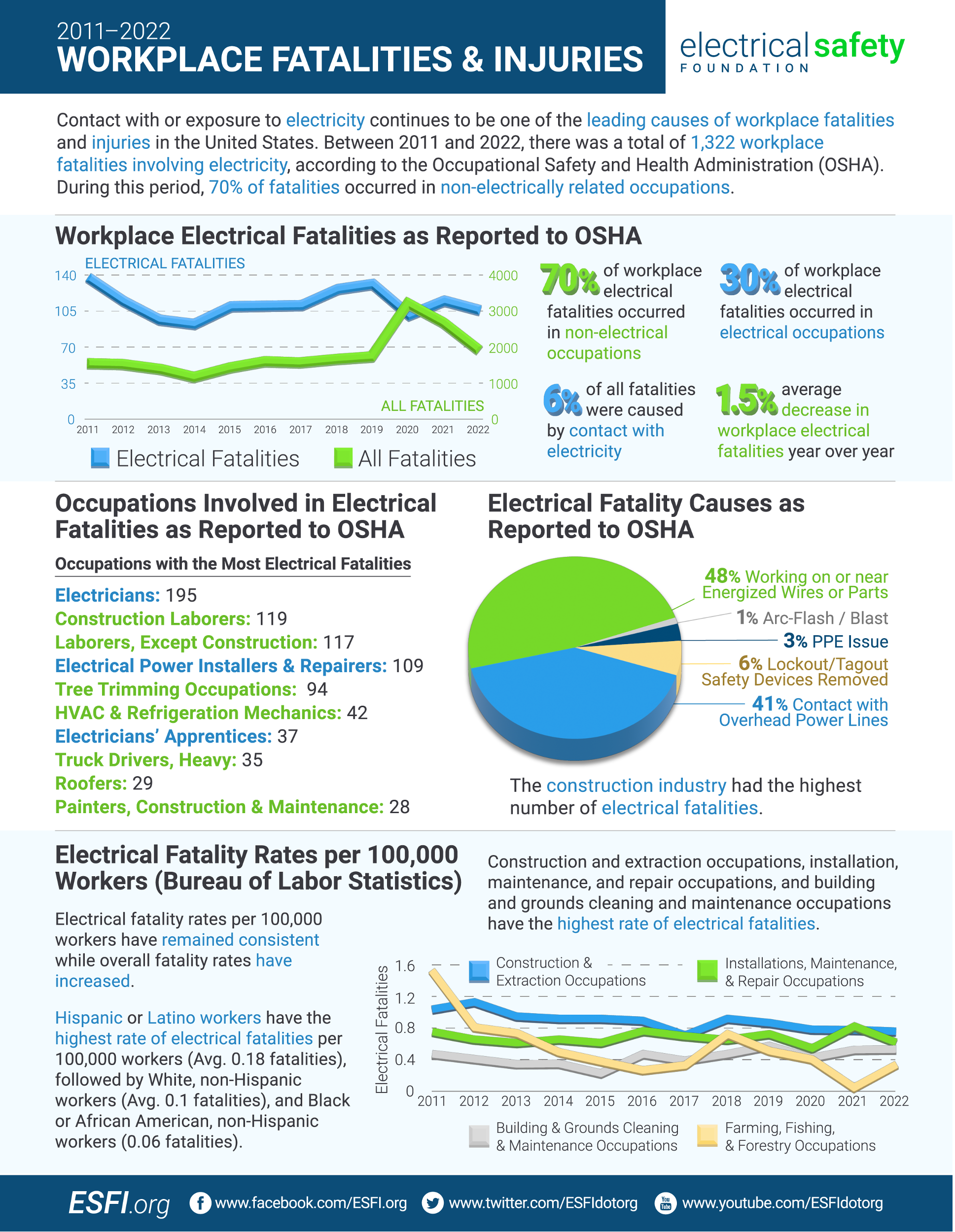ARLINGTON, Va. (Jan. 31, 2024) — Each year, the Electrical Safety Foundation (ESFI) collects information on fatal occupational electrical injuries using the U.S. Bureau of Labor Statistics (BLS) Census of Fatal Occupational Injuries (CFOI) and Survey of Occupational Injuries (SOII), as well as the Occupational Safety and Health Association (OSHA) Accident Investigation reports. ESFI then publishes the information in tabular and graphical form to esfi.org. The most recent data set covers the 11 years from 2011 to 2022.

Contact with or exposure to electricity continues to be one of the leading causes of workplace fatalities and injuries in the United States. Between 2011 and 2022, there was a total of 1,322 workplace fatalities involving electricity, according to OSHA. During this period, 70% of fatalities occurred in non-electrically related occupations. The data high points are as follows:
Workplace Fatalities & Injuries: 2011–2022
- Seventy percent of workplace electrical fatalities occurred in non-electrical occupations.
- Thirty percent of workplace electrical fatalities occurred in electrical occupations.
- Six percent of all fatalities were caused by contact with electricity.
- There was a 1.5% average decrease in workplace electrical fatalities year over year.
- The construction industry had the highest number of electrical fatalities.
Occupations With the Most Electrical Fatalities
- Electricians: 195 fatalities
- Construction laborers: 119 fatalities
- Laborers, except construction: 117 fatalities
- Electrical power installers and repairers: 109 fatalities
- Tree trimming occupations: 94 fatalities
- HVAC and refrigeration mechanics: 42 fatalities
- Electricians’ apprentices: 37 fatalities
- Truck drivers, heavy: 35 fatalities
- Roofers: 29 fatalities
- Painters, construction and maintenance: 28 fatalities
Electrical Fatality Rates per 100,000 Workers (BLS)
- Electrical fatality rates per 100,000 workers have remained consistent while overall fatality rates have increased.
- Hispanic or Latino workers have the highest rate of electrical fatalities, and that rate is increasing.
- Construction and extraction occupations, installation, maintenance, and repair occupations, and building and grounds cleaning and maintenance occupations have the highest rate of electrical fatalities.
ESFI partners with industry leaders, including those comprising its board of directors, to develop key resources and consistent electrical safety messages. By addressing evolving and emerging electrical safety needs in the workplace and then deploying effective electrical safety materials and programs based on those needs, electrical injuries and fatalities can decrease through proper education of the workforce.
“Non-electrical occupations account for 70% of all workplace electrical fatalities, so it is imperative for all occupations to understand the dangers of working on or near energized equipment," said ESFI Program Manager Daniel Majano. "ESFI is pivotal in raising awareness of workplace hazards to help reduce the number of workplace electrical incidents occurring yearly to zero.”
The mission of ESFI is to prevent electrically-related injuries, deaths, and fires, saving lives and property through public education and outreach. Visit esfi.org.
